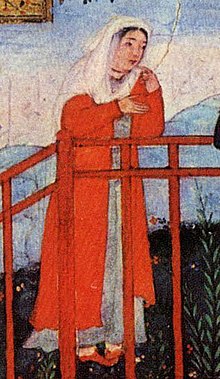| Khas Mahal | |
|---|---|
 Detail of Khas Mahal from a painting | |
| Spouse | |
| House | Timurid (by marriage) |
| Father | Zain Khan Koka |
| Religion | Islam |
Khas Mahal (Persian: خاص محل), meaning "The exquisite one of the palace", was one of the chief wives of the Mughal emperor Jahangir.
Family[edit]
Khas Mahal was the daughter of Zain Khan Koka.[1] Zain Khan was the son of Khawajah Maqsud of Herat and Pija Jan Anga, foster-mother of Emperor Akbar.[2] Khan's paternal uncle, Khawajah Hassan's daughter, Sahib Jamal had been married to Jahangir, and was the mother of his son Prince Parviz Mirza.[3]
Khas Mahal had two brothers, named Zafar Khan and Mughal Khan. The former served under Akbar and Jahangir,[4] and died on 7 March 1622.[5] The latter served under Jahangir and his son Shah Jahan, and died on 1 July 1657.[6] A sister of Khas Mahal was married to Mirza Anwar, a son of Mirza Aziz Koka, Akbar's foster-brother.[7]
Marriage[edit]
In 1596 Prince Salim (future Emperor Jahangir) became violently enamored of her and meditated on marrying her. Akbar was displeased at the impropriety.[8] The cause of Akbar's objection was Sahib Jamal who had already been married to Salim. Akbar objected to marriages between near relations.[9]
However, when Akbar saw that Salim's heart was immoderately affected, he, of necessity, gave his consent. There was a great feast and joy. The marriage took place on the eve of 18 June 1596 at the house of Dowager empress Hamida Banu Begum.[9]
When Jahangir ascended the throne, Khas Mahal became empress. Sir William Hawkins, a representative of the English East India Company noted her among Jahangir's chief wives. He said the following:
Hee (Jahangir) hath .... three hundred wives whereof four be chiefe as queenes, to say, the first, named Padasha Banu (Saliha Banu Begum), daughter to Kaime Chan (Qaim Khan); the second is called Noore Mahal (Nur Jahan), the daughter of Gais Beyge (Mirza Ghiyas Beg); the third is the daughter of Seinchan (Zain Khan); the fourth is the daughter of Hakim Humaun (Mirza Muhammad Hakim), who was brother to his father Ekber Padasha (Akbar)[10]
Architecture[edit]
In 1642–43, Khas Mahal commissioned a palace near the old fort in the neighborhood of Nizamuddin, Delhi.[11][12][13]
In popular culture[edit]
Khas Mahal is a character in Jyoti Jafa's historical novel Nur Jahan: A Historical Novel (1978).[14]
References[edit]
- ^ Desai, Ziyaud-Din A. (2003). Purā-prakāśa: Recent Researches in Epigraphy, Numismatics, Manuscriptology, Persian Literature, Art, Architecture, Archaeology, History and Conservation: Dr. Z.A. Desai Commemoration Volume, Volume 1. Bharatiya Kala Prakashan. p. 281. ISBN 978-8-180-90007-5.
- ^ Walthall, Anne (June 10, 2008). Servants of the Dynasty: Palace Women in World History. University of California Press. p. 103. ISBN 978-0-520-25443-5.
- ^ Beale, Thomas William (1881). The Oriental Biographical Dictionary. Asiatic Society. pp. 216.
- ^ Shīrāzī, Kāmī (2003). Fath nama-i Nur Jahan Begam. Rampur Raza Library. p. 36. ISBN 978-8-187-11360-7.
- ^ Jahangir, Emperor; Thackston, Wheeler McIntosh (1999). The Jahangirnama : memoirs of Jahangir, Emperor of India. Washington, D. C.: Freer Gallery of Art, Arthur M. Sackler Gallery, Smithsonian Institution; New York: Oxford University Press. pp. 376. ISBN 978-0-19-512718-8.
- ^ Abū al-Fazl ibn Mubārak (1874). The Ain i Akbari, Volume I. Rouse. p. 346.
- ^ Bhakkari, Shaikh Farid (1993). The Dhakhiratul-khawanin: a biographical dictionary of Mughal noblemen. Idarah-i Adabiyat-i Dehli. p. 117.
- ^ Awangābādī, Shāhnavāz Khān; Prasad, Baini; Shāhnavāz, 'Abd al-Hayy ibn (1979). The Maāthir-ul-umarā: Being biographies of the Muḥammadan and Hindu officers of the Timurid sovereigns of India from 1500 to about 1780 A.D. Janaki Prakashan. p. 1027.
- ^ a b Beveridge, Henry (1907). Akbarnama of Abu'l-Fazl ibn Mubarak - Volume III. Asiatic Society, Calcutta. pp. 1058–9 n. 3.
- ^ Foster, Sir William (1975). Early travels in India, 1583-1619. AMS Press. pp. 100–101. ISBN 978-0-404-54825-4.
- ^ Parihar, Subhash (January 1, 2008). Land transport in Mughal India: Agra-Lahore Mughal highway and its architectural remains. Aryan Books International. p. 84. ISBN 978-8-173-05335-1.
- ^ Archeological Survey of India (1990). Annual Report. Swati Publications. p. 24.
- ^ Khan, Sir Sayyid Ahmad (1978). Monuments of Delhi: Historical Study. Ambika. p. 57.
- ^ Jafa, Jyoti (1978). Nur Jahan: A Historical Novel. Writer's Workshop. p. 18.